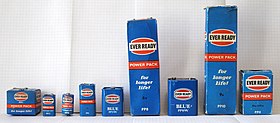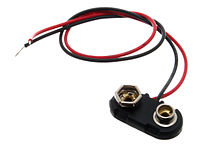9 Volt Battery Positive Negative

Vintage PP3-size 9-volt batteries

The nine-volt battery, or 9-volt battery, is an electrical battery that supplies a nominal voltage of 9 volts. Actual voltage measures 7.two to 9.six volts, depending on battery chemistry. Batteries of various sizes and capacities are manufactured; a very common size is known as PP3, introduced for early on transistor radios. The PP3 has a rectangular prism shape with rounded edges and 2 polarized snap connectors on the top. This type is normally used for many applications including household uses such as smoke and gas detectors, clocks, and toys.[1]
The nine-volt PP3-size battery is commonly bachelor in primary zinc-carbon and alkaline chemistry, in primary lithium iron disulfide and lithium manganese dioxide (sometimes designated CRV9[2]), and in rechargeable form in nickel-cadmium (Ni–Cd), nickel-metal hydride (Ni–MH) and lithium-ion. Mercury batteries of this format, once common, accept been banned in many countries due to their toxicity.[iii] Designations for this format include NEDA 1604 and IEC 6F22 (for zinc-carbon) or MN1604 6LR61 (for alkaline). The size, regardless of chemical science, is commonly designated PP3—a designation originally reserved solely for carbon-zinc, or in some countries, Eastward or E-cake.[four] A range of PP batteries was produced in the by, with voltages of 4.5, 6, and ix volts and different capacities; the larger nine-volt PP6, PP7, and PP9 are still available. A few other 9-volt bombardment sizes are bachelor: A10 and A29.[2]
Well-nigh PP3-size element of group i batteries are synthetic of six private ane.5 V LR61 cells enclosed in a wrapper.[five] These cells are slightly smaller than LR8D425 AAAA cells and can exist used in their place for some devices, even though they are iii.5 mm shorter. Carbon-zinc types are made with 6 apartment cells in a stack, enclosed in a moisture-resistant wrapper to prevent drying. Primary lithium types are made with three cells in serial.[six]
ix-volt batteries accounted for iv% of alkaline primary battery sales in the United States in 2007, and 2% of chief battery sales and ii% of secondary (rechargeable) bombardment sales in Switzerland in 2008.[7] [8]
History [edit]

PP (Power Pack) battery family from left to right: PP1, PP3, PP4, PP6, PP7, PP8, PP9, PP10, PP11
Historically, the now popular PP3 bombardment size was a member of the PP (Power Pack) battery family unit that was originally manufactured by Ever Set up in the United Kingdom and Eveready in the United States. The company says that information technology introduced the PP3 battery in 1956,[ix] having been added every bit an ANSI standard in 1959, currently known as ANSI-1604A.[10]
| Proper name | Voltage | Capacity | Depth | Width | Tiptop |
|---|---|---|---|---|---|
| PP1 | 6 volt | 4. Ah | 55.6 mm | 65.1 mm | 55.half-dozen mm |
| PP3 | 9 volt | 0.v Ah | 17.5 mm | 26.5 mm | 48.5 mm |
| PP4 | 9 volt | 0.9 Ah | Dia. 25.8 mm, length: 49.viii mm; 41.5 mm ex. contacts | ||
| PP6 | 9 volt | 1. Ah | 34.1 mm | 35.vii mm | 69.9 mm |
| PP7 | 9 volt | 2.v Ah | 46 mm | 46 mm | 63 mm |
| PP8 | 6 volt | 15. Ah | 55 mm | 61 mm | 200 mm |
| PP9 | 9 volt | five. Ah | 51.5 mm | 65 mm | 80 mm |
| PP10 | 9 volt | 15. Ah | 66 mm | 65 mm | 267 mm |
| PP11 | 4.five volt × two | v. Ah | 51.five mm | 65 mm | 91 mm |
The PP11 consists of two isolated 4.5-volt batteries with four terminals.
Merely the PP3, PP6, PP7 and PP9 sizes are still manufactured, with the PP3 being extremely common. Modern batteries take higher chapters and lower internal resistance than early versions.
Before the mid-1950s, in the days of vacuum tube (valve) radios used batteries designed specifically for vacuum tubes, there was a nine-volt grid bias battery or (US) "C" battery, which had taps for various voltages from 1.5 to nine volts.
Early on transistorized radios and other equipment needed a suitable voltage miniature battery. Early transistor radios required a 22+ ane⁄2 volt bombardment. Although the transistors would theoretically operate from lower voltages, the bespeak-contact transistors used in 1954 had to be operated very close to their VCB0 limit in order to get the required frequency response. Nevertheless, a suitable miniature battery was already marketed for (vacuum tube) hearing aids.
The PP3 (physically identical to 6LR61 or 1604A) appeared when portable transistor radios became mutual, and is nonetheless called a "transistor" battery by some manufacturers.
PP3 connectors [edit]

The PP3 battery has both terminals in a snap connector on one end. The smaller circular (male) final is positive, and the larger hexagonal or octagonal (female) terminal is the negative contact. The connectors on the battery are the same as on the load device; the smaller one connects to the larger one and vice versa.[5] The aforementioned snap-way connector is used on other bombardment types in the Ability Pack (PP) series. Battery polarization is normally obvious, since mechanical connection is usually only possible in one configuration.
A problem with this type of connector is that 2 loose batteries with terminals exposed tin can touch and brusk circuit, discharging them, and generating heat and peradventure a fire.[1] Keeping nine-volt batteries in their packaging until utilise helps to avoid accidental belch.[11]
Technical specifications [edit]

Three dissimilar kinds of nine-volt primary battery internals: rectangular cell zinc-carbon (6F22), rectangular cell alkaline (6LP3146), and cylindrical cell alkaline metal (6LR61)

Rechargeable (NiMH) ix-volt bombardment internals (stacked, 6HF~viii/~22/~17)[a]
Very oftentimes, a "9-volt" battery refers to the transistor radio size called PP3 or IEC 6F22 or NEDA 1604, although there are less common nine-volt batteries of different sizes.
Batteries of all types are manufactured in consumer and industrial grades. Costlier industrial-grade batteries may use chemistries that provide college power-to-size ratio, have lower self-discharge and hence longer life when not in use, more than resistance to leakage and, for instance, ability to handle the loftier temperature and humidity associated with medical autoclave sterilization.[12]
| Blazon[b] | IEC proper noun[c] [13] | ANSI/NEDA name[fourteen] | Typical capacity (mAh) | Typical capacity (Wh) | Nominal voltages | |
|---|---|---|---|---|---|---|
| Chief (disposable) | Alkali metal, vi-cylinder | 6LR61 | 1604A | 550 | four.95 | ix |
| Alkali metal, six-stack | 6LP3146[15] | 1604A | 550 | 4.95 | 9 | |
| Zinc–carbon | 6F22 | 1604D | 400 | 3.6 | 9 | |
| Lithium | (varies) | 1604LC[d] | 1200 | 10.8 | nine | |
| Rechargeable | Ni–Cd | 6KR61 | 11604 | 120 | 0.864, 1.008 | 7.2, 8.4 |
| Ni–MH | 6HR61 | seven.2H5 | 175–300 | i.26-two.16, one.47-2.52, 1.68-2.88, | 7.2, 8.iv, 9.6 | |
| Lithium polymer | (varies) | — | 520 | three.848 | vii.4 | |
| Lithium-ion | (varies) | — | 620 | 4.588 | 7.four | |
| Lithium iron phosphate | — | — | 200–320 | 1.92-iii.072 | nine.six | |
Testing and charging [edit]
Most battery voltage testers and chargers that tin too test nine-volt need another snap clip to concur the bombardment, while cylindrical batteries often share a holder that may be adjustable in size. Because of the proximity of the positive and negative terminals at the elevation of the battery and relatively low current of almost common batteries, one informal method of testing voltage is to place the two terminals beyond a natural language. A strong tingle would indicate a bombardment with a strong charge, the absence, a discharged battery. While there have been stories circulating of unfortunate outcomes, the process is rarely dangerous under normal circumstances, though it may exist unpleasant.[16]
Lithium [edit]
Lithium 9-volt batteries are dispensable high-free energy-density batteries. In the PP3 size they are typically rated at 0.8–1.2 Ah (east.thou. >ane.ii Ah @ 900 ohms to 5.4 V @ 23 °C for one type),[17] most twice the chapters of element of group i batteries. Some manufacturers claim the free energy density can be v times that of element of group i.[17] Common applications for lithium nine-volt batteries are fume and carbon monoxide detectors.[6]
See also [edit]
- Battery eliminator
- Bombardment nomenclature
- Listing of battery sizes
- Listing of battery types
- Self-discharge
Notes [edit]
- ^ Presumed cell size.
- ^ Some types are not plant in a battery nomenclature, hence Northward/A.
- ^ The granularity of IEC nomenclature means that each cell may have more than one match. This is partially due to the chemistry types being open to estimation (especially for lithium cells) and partially due to the possibility of different geometric constructions (e.chiliad. stacked versus cylinder). For case, the NiMH lawmaking listed in the table (6HR61) assumes a cylindrical geometry and would non utilise to the pictured NiMH cell.
- ^ In that location is a similar upshot in "lithium" being vague here. The example gives LC, the 3-volt Li–MnOii system. Alternatively vi i.6-volt Li–FeS2 cells may be used, giving 1604LF (or 6FR61 in IEC).
References [edit]
- ^ a b "ix-Volt Battery Rubber". National Fire Protection Clan. 2016. Archived (PDF) from the original on 2016-07-27. Retrieved 2022-05-01 .
- ^ a b "Non-Rechargeable Batteries (filtered for 9V)". CPC Farnell. Retrieved 2022-04-22 . 9-volt batteries supplied by a typical distributor: PP3 (or CRV9), PP6, PP7, and PP9 are the PP sizes; A10 and A29 the but other 9v types.
- ^ Hunter, Rod; Muylle, Koen J., eds. (1999). European Community Deskbook. An ELI deskbook - ELR - The Environmental Law Reporter. Environmental Police force Institute. p. 75. ISBN0-911937-82-10.
- ^ "AP300 NiMH 9 Volt 300mAh". AccuPower. Archived from the original on 2018-02-06. Retrieved 6 Feb 2018.
- ^ a b IEC 60086-two-2011 §seven.6.1.12
- ^ a b Lee, Arthur (2002-06-28). "Preliminary Test Results on Lithium Batteries Used in Residential Smoke Alarms" (PDF). CPSC.gov. U.S. Consumer Product Safety Commission. Archived from the original (PDF) on 2017-02-23. Retrieved 2022-07-24 .
- ^ "Life Cycle Impacts of Alkaline Batteries with a Focus on Stop-of-Life" (PDF). EPBAEurope.net. EPBA-EU. Archived from the original (PDF) on 2016-03-03.
- ^ "INOBAT 2008 Statistics" (PDF). INOBAT.ch. Archived from the original (PDF) on 2012-03-25.
- ^ "Battery History". Analeptic. Retrieved 2018-02-16 .
- ^ "Product Datasheet: Analeptic 522" (PDF). Energizer. 2019-x-25. Retrieved 2022-03-26 .
- ^ "9 Volt Batteries a Burn Risk". Division of Fire Safety – NH Section of Safety. 2017-01-29. Archived from the original on 2017-01-29.
- ^ Adams, Louis (November 2015). "Powering Tomorrow'south Medicine: Critical Decisions for Batteries in Medical Applications". Medical Design Briefs.
- ^ IEC 60086-2011 pt2-§vii.6.one.12
- ^ ANSI C18.1M Part 1 and C18.3M Part 1
- ^ "MN1604" (PDF). Bethel, Connecticut: Procter & Gamble. Archived from the original (PDF) on 2018-05-27. Retrieved 2022-02-12 .
- ^ "The Science of Licking a 9V Battery". SparkFun.com.
- ^ a b "Farnell: Datasheet for Ultralife U9VL-J-P 9V lithium manganese dioxide PP3-size battery" (PDF). Farnell.com.
External links [edit]
-
 Media related to PP3 batteries at Wikimedia Commons
Media related to PP3 batteries at Wikimedia Commons
9 Volt Battery Positive Negative,
Source: https://en.wikipedia.org/wiki/Nine-volt_battery
Posted by: swingleketter.blogspot.com


0 Response to "9 Volt Battery Positive Negative"
Post a Comment